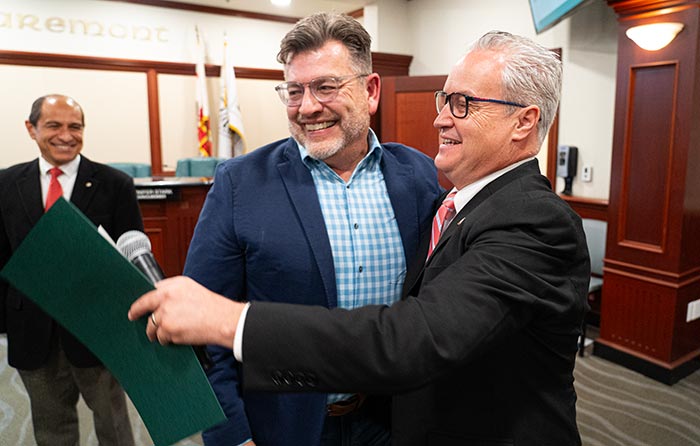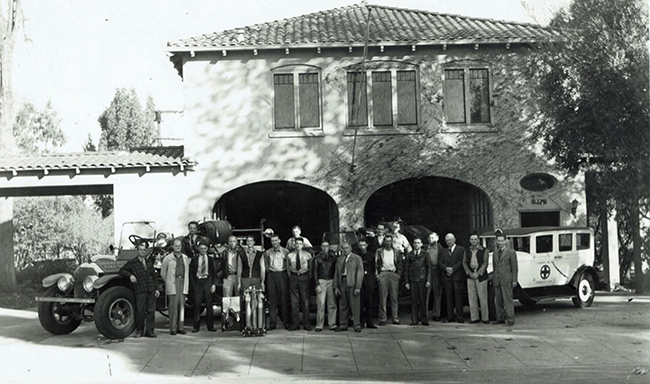City Council allocates nearly $1M for police facility upgrades

(L-R) Claremont Mayor Pro Tem Corey Calaycay, outgoing chamber of commerce CEO Randy Lopez, and Claremont Mayor Sal Medina at Tuesday’s City Council meeting. Courier photo/Andrew Alonzo
by Andrew Alonzo | aalonzo@claremont-courier.com
Ahead of a looming deadline, the Claremont City Council voted unanimously Tuesday to allocate some its remaining American Rescue Plan Act funds to partially fund for long sought improvements at the aging Claremont Police Department building.
“Under the [State and Local Fiscal Recovery Funds] program, [ARPA funding] recipients must obligate all award funds by December 31, 2024, and expend funds by December 31, 2026,” read a staff report.
Claremont has spent about $5 million of its nearly $8.7 million in ARPA funds, according to the report. The council agreed to spend $1.1 million of the city’s remaining funds by the end of 2024, with $2.6 million spent through six inter-agency agreements, leaving a balance of $618,164.
The council voted to use $150,400 of the balance for a seismic retrofit and Americans with Disabilities Act improvement project at the Claremont Police Department building, and spend the remaining $467,764 for construction of a new women’s locker room there. The city will also reallocate $317,364 from previously unspent ARPA money from projects and programs to the aforementioned CPD projects.
“Phase 1 costs for the seismic retrofit and ADA improvement project for the Police Department is estimated to be just over $1.2 million and will require additional funding appropriations,” read the report. “The construction of the Police Department women’s locker room is estimated at just over $2.6 million based on 90 percent plans being completed. Additional effort will be made by staff to identify the remaining funding sources for both projects in the months ahead.
Claremont voters have twice rejected two bond measures that would have funded a new police station to replace the 1972 building at 570 W. Bonita Ave.: the $50 million Measure PS in 2015, and a scaled down $25 million plan in 2018, Measure SC.
E-bike subsidy program gets additional funding
After much discussion, the council voted 5-0 to allow American Rescue Plan Act funds to be used for the Go San Gabriel Valley E-Bike subsidy program.
Conditions of the vote included ARPA funding from another program be sourced for this subsidy initiative, certain participants be shifted to a different e-bike program, and Claremont e-bike program users be required to provide odometer and bike usage data in upcoming surveys.
The council directed staff to use up to $90,000 in ARPA funding to continue to fund the city’s specific e-bike subsidy program for up to two-years.
The first year’s funding, at $45,000, is guaranteed. The program will be reevaluated by the end of 2025. The second $45,000 is not guaranteed and is subject to reassignment should the program lose popularity or falter in other aspects.
The measure also specified that the reallocated $90,000 be replenished if alternate funding is subsequently found for other ARPA projects.
The measure guaranteed income-qualified program participants will be transitioned to GoSGV’s income-qualified program. The city will subsidize non-income qualified participants at $25 per month, who will then be responsible for the remaining $25 monthly fee.
Lastly, participants must provide quarterly odometer readings to ActiveSGV. Periodic surveys will query them about their e-bike usage with respect to public transit connections.
The vote comes three months after city staff worked with ActiveSGV to survey Claremont e-bike subsidy users to aid the council’s understanding of the program’s effectiveness. Alex Cousins, the city’s senior management analyst, delivered the findings of the survey, which received 102 responses from the 119 program users, in a written staff report.
“The GoSGV program user survey (Attached) highlights that participants use e-bikes frequently, with 48% riding weekly and 25% daily, primarily for recreation (81%), errands (63%), and commuting (41%),” read the report. “Most trips are short, with 68% traveling one to five (1-5) miles. User satisfaction is high, averaging nine (9) out of ten (10), and 63% report cost savings compared to other transportation methods. The survey indicates that the program has been beneficial for e-bike adoption, with 83% of respondents considering purchasing an e-bike because of it. However, only 15% would continue their membership if subsidies ended, while 59% are unsure.”
Thirty-one survey participants provided their odometer readings.
“The median miles traveled was 174 miles, with the least used bike traveling only eight miles and the most with 1,104 miles traveled,” read the report. “The program had a positive impact on reducing car trips, with 42% of respondents substituting “sometimes” and 45% substituting “often” or “always.” These findings suggest the program has benefited e-bike adoption.”
CBO funding recommendations approved
The council also unanimously approved the 2025 Community Based Organization funding recommendations made by the community and human services commission at its November 6 meeting.
The CBO programs are broken into general and homeless services. Per the grant allocation policy linked at ci.claremont.ca.us, general services typically consist of efforts to strengthen social, familial, or economic ties in the community while homeless services/critical needs aim to address and prevent homelessness in the city.
The vote allocated $100,000 to be spent among 18 general services programs and $60,000 among 11 homeless services programs. To see the funding breakdown, search November 26, 2024 city council agenda at ci.claremont.ca.us and click on the “2025 CBO Funding Recommendation Spreadsheet” attachment on item 12.










0 Comments